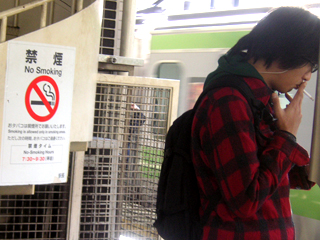December 27, 2004
I ended my internship at Frognation last Friday but I'm staying another few weeks in Japan. So from now on my blogging will be more rare due to lack of internet connection.
Until next... happy new year!'
/Maria
December 24, 2004
December 22, 2004
Treasures in Akihabara
See what I found!!! My boyfriend who is currently visiting me in Tokyo is happy as a 3 year old and shows me his treasures. He spend hours in Akihabara (also known as Electric town) looking for old style games and he found some real bargains. A shop full of small colorful and funny portable games from the late 70’s, 80’s and early 90’s and the cheapest ones where only 50 Yen! (about 3,50 kr).
The great thing about having a visitor is that I get the chance to experience Tokyo all over again and this time through his eyes. I realize that after all I’ve learned a lot of things since I got here in October. My Japanese may be very limited but still I know how to order food, ask for a different size while shopping and use everyday greetings. I don’t get lost on the trains or metro anymore and I know what to get in the grocery store even though I can’t read.
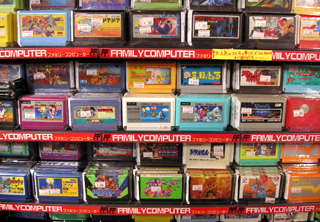
PS. Happy birthday Osing who is turning 22 today!
December 21, 2004
Interesting meetings
I had the opportunity to join Masuyama for an interview with a writer and take a look around the Shonen Magazine office recently (Shonen Magazine is a famous manga magazine for young men).
The 39 year old Hiro Nakajima, the writer of the book “Secrets of a happy millionaire from Hawaii – less work more money – 42 rules to become a successful entrepreneur” looked just like you would picture a professional kite surfer living in Hawaii. He had long hair, wearing a Hawaii shirt and was very suntanned. The interview lasted for 1,5 hour and was filled with laughter, that I could tell even though my Japanese is very limited.
We continued in a taxi to Gokokuji to see the Shonen Magazine office (my first car ride in Tokyo!). The office itself looked more or less like other Japanese offices I’ve visited except for all the colorful manga posters covering the walls. I was introduced to both editors and manga artists and I got an idea of what it was like working there. Most of the employees were male... I wonder if it’s the other way around in a “girls magazine’s office”?

December 20, 2004
Dressed for winter?
You can’t complain about cold weather – you’re from Sweden! I’ve heard it a lot lately but it’s not true. Just because I live in a colder place usually doesn’t mean I’m better suited for cold weather or even that I would like it. What surprises me in Tokyo though is that people complain on cold days about the weather and still they wear clothes and shoes that are not meant for being used during winter season.
It’s really trendy among girls these days to wear shorts or cut off pants over thin stockings. You see it all over Tokyo – but it must be so cold. I don’t understand it. A lot of women have high heel shoes but not boots but sandals and some of them without stocking and having a short skirt – in December! It’s craziness to me. And I won’t even talk about the school uniforms for the young boys (their shorts cover approx. 3 cm of their legs and they have to wear them all year round…).
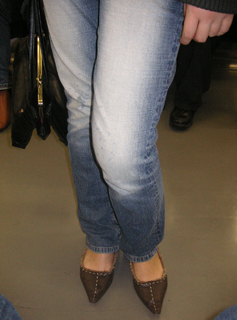
No socks as usual...
December 17, 2004
How to live cheap in Tokyo
Tokyo is considered one of the most expensive cities in the world. Is it possible to live here as a “poor” student? I would say yes, for sure. Here are my tips on how to save money and still have a good time in Japan:
1. Hang out with Japanese people. It’s fun and they’ll give you valuable info you won’t ever find in guidebooks. Sharing an appartment is both cheap and fun!
2. Be nice to your neighbors. (I always get a discount at my local bakery, don’t ask me why… but nice isn’t it?).
3. Be sure to do your grocery shopping right before the store is closing. That’s when you can get bread, fish and meat a lot cheaper than usual.
4. If you are traveling out of Tokyo the slow trains are always cheaper, sometimes 50%.
5. The Metro is usually cheaper than JR trains.
6. Big supermarkets often have tryouts, if you are lucky you can save a lunch by nibbling on crackers, trying some pineapple, fish burgers, soups etc.
7. NOODLES! Needs no further explanation…
8. The cheapest food to make at home is definitely soup. A miso base (paste made from fermented soya beans) and you can chop any vegetable and put in and it will tasty yummy. (My current favorite soup contains: satsumaimo (sweet potato), enooki mushrooms, onion, bacon and Chinese cabbage).
9. There are actually quite a few museums where you can enter for free. Parks are free too and some of them have bikes you can borrow.
10. If you’d rather stay indoors there are tons of showrooms where the major Japanese and international companies exhibit their latest products. It’s very creatively displayed and you can see the latest electronic products (like robots, try out the latest software on a giant, high-quality monitor etc.).

December 16, 2004
What if...? Part 1
What if someone throws up in the train? I have thought about it a few times and I’m quite sure it must happen every day somewhere in Tokyo. It is inevitably and you can’t really avoid the situation. A sick person, a drunken person or just an accident.
I asked a few Japanese friends and all of them had been in a train where someone threw up (never been hit luckily). Their advice to me was: don’t stand too close to really drunk people in the trains (quite hard since the Yamanote line always is crowded). I wonder if that advice includes my friends on a Saturday night as well... ;)
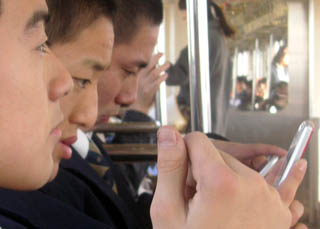
PS. Today’s topic was decided this morning. I had a delicious lunch with my co-workers and there is absolutely no connection between today’s lunch and today’s blog. Just to let you know. :)
December 15, 2004
Tokyo's greatest café
If you get off at Tokyo JR Station (Marunouchi exit) and walk a few minutes towards the Imperial Palace you will find the Dragonfly Café on your left. It’s my all-time favorite café in Tokyo.
It consists of a light and airy room with untreated board flooring, white walls and it is high up to the ceiling. They have several lamps made out of old glass bottles and simple but nicely design furniture.
The food is a mix between traditional Japanese food and Western food. You can get a huge rice bowl with grilled meat and tomatoes for 1000 Yen (typ 65 kr). They have a superb blood orange juice and the desserts – I almost forgot – how great they are. You can get a piece of apple and sweet potato cake or just a plain cop of tea if you prefer something simple. Just writing this makes my mouth watering. I have to go there soon – what about this Saturday?
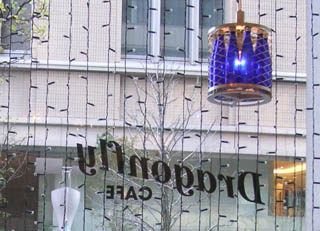
December 14, 2004
Read on lucky ones!
The range of magazines in Japan is just incredible. There are magazines for any hobby or interest you could ever imagine. Of course with a population of 127 millions you have to offer the citizens descent and enjoyable reading with lots of variety.
I’ve seen magazines about trains, shiba dogs, snowboarding girls, male hairdos, pretty much anything. This amazes me coming from a small country (population wise) where new magazines usually lasts only a few issues soon to go bankrupt. We are unfortunately too few to have narrow magazines like in Japan. So to the people of Japan – read on, you have no idea how lucky you are!

PS. Happy Birthday Mi who's turning 23 today! :)
December 13, 2004
Beautiful sumos
I’m actually surprised I haven’t seen any sumos before since I live only a few stops from the famous “Kokugi-kan Sumo Arena”. Waiting for the train to Ueno to see Tomoko last Saturday I suddenly spotted two giants. I had only seen them on TV before, never in real life and I was totally amazed. They wore beautiful male kimonos and their hair was neatly done. We entered the same train and I couldn’t help staring at them the whole ride through. They talked cheerfully to each other and once in a while they touched each others hair to make sure it looked nice and proper.
I didn’t want to miss the opportunity so when the three of us left the train I asked if I could take their picture and I could. So here is my proof to you all – I’ve seen two sumo wrestlers!

PS. For all the Swedish people: enjoy your Lucia celebrations!
December 10, 2004
X-mas in Tokyo
I love the lights decorating the trees and buildings all over Tokyo during December. But in the daytime it looks kind of ugly, with green plastic trees, bright purple balls and lots of cords. What I miss though is the smell of fresh spruce twigs that are decorating shop windows all over my home city in December.
The Christmas cake I see in bakeries all over Tokyo looks like a typical birthday cake for children with cream and strawberries. I’ve never had such a thing for Christmas in Sweden. But a common Swedish Christmas dessert is actually cooked rice pudding with fruit syrup.
My boyfriend will come visit me for Christmas and together with some friends we’ll have a Christmas dinner with Swedish/Japanese food. Can’t wait to have sushi and glögg! ;)

December 09, 2004
Watch out for the girls
You see them everywhere in Tokyo, in big groups or just two and two, Japanese schoolgirls in their uniforms on their way to school or on their way back home. The pattern of their skirts may vary and so does the length.
The usually blue school bag hangs from their shoulders and their mobiles are covered by stickers and beads with toys and bells hanging down. They giggle and talk loud in the trains and I’m always curious what they are saying. My Japanese friend told me they usually have their own language based on slang and colloquial language so it might be hard even for a Japanese person to fully understand them.
Personally they make me feel a little uncomfortable since I’m picturing the wild and evil Japanese school girl (Go-go Yubari) in my head from Quentin Tarantino’s movie “Kill Bill 1”. I can’t help it, they look so young and harmless but you never know, they might carry a sword in their handbag, who knows?

December 08, 2004
Okashi to the people!
What would Japan be without its great and various okashi (general word for Japanese sweets and snacks)? The rich and tasty daifuku (sweet bean paste in rice cake) that is green and floury. Yookan (chunky sweet bean jelly) which is usually very sweet and deep brown or purple. Ebi-sen (shrimp flavored fried flour sticks) that are a little salty and really tasty. Karintoo (fried sugar-coated dough) looks like brown sticks and are really sweet. Karikari ume (crunchy pickled plum) that wouldn’t probably appeal to most foreigners because it might taste weird at first, but I assure you it’s yummy.
Japanese snacks can be very sweet, so it goes well with the bitter green tea. Are you heading for Japan? Don’t miss out great stuff like: choko-reeto, sunakku and aisu (chocolate, snacks and ice-cream).
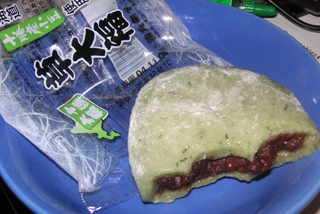
Daifuku break at work...
December 07, 2004
Bring a cake
It is custom to bring something for the host and hostess when you’re invited to someone’s house. In Sweden you usually bring a bottle of wine, flowers, a box of chocolate or something homemade (like marmalade, jelly etc). In Japan the most common thing to bring is a dessert, usually from a nice bakery brought in a small box.
I think it’s a great custom, not just because I’m very fond of desserts, but also because if the hosts have cooked they should be released from further work and enjoy the dessert without moving a finger. Right?!
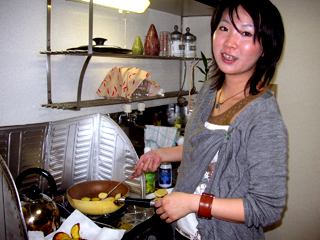
- Where is my cake? I surely deserve it!
PS. Erik – happy anniversary!
December 06, 2004
Relaxing in Hakone
It took us two hours standing on a packed train to get to the Hakone area. It was definitely worth it though. My friends and I headed of to a close onsen (a Japanese hot spring) with a local bus. This specific onsen had four different baths with different temperatures, three of them outdoors. It was wonderful to sit back and relax the hot spring with bubbles, feeling the cool breeze and watch the hills around where the trees were changing leaves. So beautiful and relaxing at the same time.
Hakone is famous for its fresh tofu and we decided to have some soba (a special kind of Japanese noodles) and tofu soup. Mine was full of mountain mushrooms and vegetables I’ve never seen before. It was delicious and seemed very healthy. We were lucky to get a sunny day to stroll around the small city for a while before we left for Tokyo.
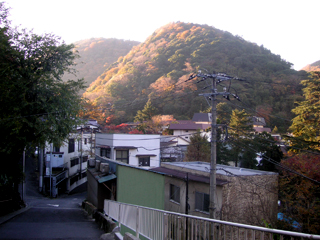
December 03, 2004
My stay at a Ryokan
Last night I stayed at a traditional Japanese hotel, also known as a “Ryokan”. It was a welcoming and quiet place, nicely decorated with Japanese tatami mats and typical Japanese furniture and futons. It was situated in an old part of Tokyo with small wooden houses and tiny stores selling flowers, fruits, rice crackers and Japanese handicrafts.
The owner and his family of six people had run the hotel for 53 years. The majority of the guests were international but still a few Japanese business men stayed there to enjoy the simple but cozy rooms instead of a boring and impersonal western style hotel. I totally understand them. I enjoyed a long relaxing bath and lots of green tea. It felt like a spa visit almost! Finally I went to the sembei shop close by to have a look at my favorite rice crackers.
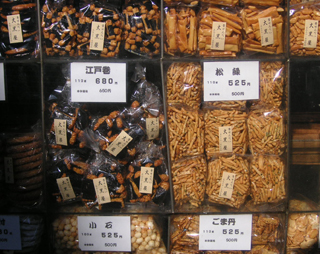
December 02, 2004
Three Japanese women
There are three women in my Tokyo life. They are close friends to me and I always have a good time hanging out with each one of them.
Ai
She’s 22 and speaks Japanese, English and French – wow. She is my roommate but I don’t see her too much because she’s a hard working girl (a receptionist in a French food company as well as late nights in a movie theatre). We eat Korean barbecue, go to art exhibitions and cook Swedish/Japanese food together. Her passion is traveling and her most recent trip was to the Maldives.

Nana
A 25 year-old computer programmer who is crazy about New York City, Jack Daniel’s and Jean Paul Gaultier. Her balcony is always sunny and has a great view of central Ikebukuru. Nana knows the best restaurants and bars in Tokyo. She is a warm and generous person but still she seems scary to some people.
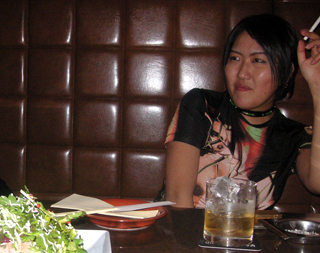
Tomoko
She is a role model in many ways. 64 years old and travels around the world on her own. Tomoko is working as a nurse and enjoys scuba diving and aerobics when she's off duty. She cooks the best Japanese food I’ve ever had. We randomly met in Lisbon in 2002, but she usually lives in Saitama with her husband, her youngest son and a cat named Mikjang.
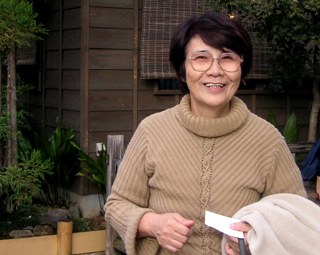
December 01, 2004
Politeness indeed
The Japanese politeness is known all over the world. People are very friendly and always trying to help you out, whatever trouble you might run into. But there is one exception – the Japanese smoking.
A vast majority of the Japanese people seem to be heavy smokers. Leaving a train station you will immediately be surrounded by a big crowd puffing and blowing smoke in your face (not intentionally but still). In a restaurant you will probably get more smoke than food if you don’t sit in a non-smoking area (they are rare).
Smoking was probably the biggest culture shock I experienced when I got to Japan. Where I’m from the concern of people with allergies, children and people working in smoking environments (like waitresses) is very important. After all – we all need to breathe, where as smoking is a choice.
